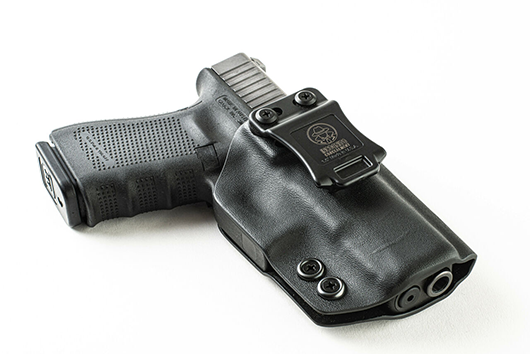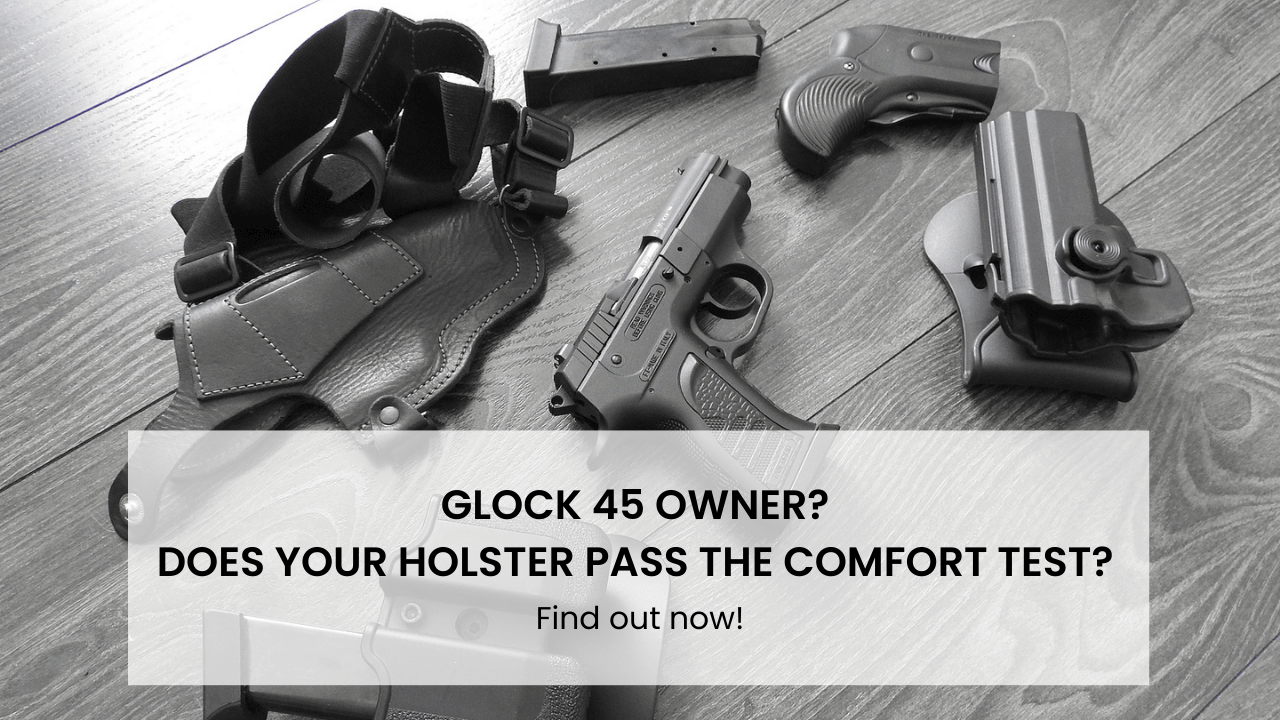Shopping Gun Holsters -What to Know Before Pulling the Trigger
Oct 5th 2021

According to a Crime Prevention Research Center report, there were 18.66 million concealed carry permits in the U.S. in 2019. This number increased in 2020 due to the pandemic, civil unrest, and other factors. If you’re new to concealed carry or seeking to upgrade your holster, it’s a good idea to evaluate your requirements to find the best option available.
Holsters are sold in various materials and designs, allowing you to carry your handgun in several positions. How you carry your firearm and under what circumstances is a personal matter that requires careful consideration. Your choice of holster is one of the most important decisions you can make regarding personal protection.
Essential Holster Criteria
For a holster to be suitable for self-defense, it must meet a specific set of criteria to ensure optimal performance.
Retention
Retention describes the ability of your holster to securely hold your firearm in place, ensuring that it doesn’t fall out during periods of vigorous physical activity. When you’re running, fighting, or seeking cover, you need to know your weapon will remain securely by your side. A lack of confidence in your holster’s retention can cause you to periodically check your weapon, potentially disclosing your armed status to bystanders. This defeats the purpose of carrying a concealed handgun.
Holster retention can be divided into two categories: Passive and active. In a passive retention holster, typically designated Level 1, there are no locking mechanisms or fasteners to secure your weapon. The holster retains the weapon due to the friction between the interior surfaces of the holster and the exterior surfaces of the firearm.
To draw your weapon from a passive retention holster, all you have to do is grip the weapon firmly and apply upward pressure. While suitable for concealed carry, passive retention is less appropriate for open carry, as your weapon is fully exposed.
There is at least one fastener or locking mechanism in an active retention holster that you must manually deactivate before drawing your weapon. An example would be a thumb break or strap that you unsnap when placing your hand on the gun. Active retention holsters are designated Level 2, 3, or 4, depending on the number of retention devices.
While active retention complicates the draw stroke, it increases the security of your weapon when carrying openly. This is why law-enforcement officers typically use active-retention holsters. If a criminal assailant attempts to disarm a police officer, it’s inherently more difficult when the holster has one or more locking devices.
Safety
While retention plays a role in the safety of your holster, it’s not the only factor. A safe holster must also protect the firearm, incentivize safe practices, and prevent the trigger from being unintentionally activated.
As a result, any holster suitable for concealed or open carry should have a fully enclosed trigger guard. When you place your hand on the weapon, your index finger should not be able to enter the trigger guard until you perform a complete draw stroke.
In addition, the holster mouth should retain its shape, remaining rigid. When you draw your weapon, the holster mouth should remain open. If the holster mouth collapses, you’ll need to open it with your support hand to re-holster your firearm, increasing the risk of your covering yourself with the gun’s muzzle.
Concealability
If you’re carrying your firearm concealed, many factors contribute to your ability to hide your weapon effectively. These include your wardrobe, carry method and position, firearm type, gun belt, and holster choice. All these factors must work together to reduce the incidence of printing, where your gun or holster produces an identifiable silhouette through clothing.
A low-profile holster design that remains close to your body can minimize this effect. The ride height and cant should be adjustable, allowing you to determine exactly how you want to carry your firearm to maximize concealability and accessibility.
Accessibility
You should be able to acquire a full firing grip on the weapon and perform an efficient draw stroke to respond to a deadly threat. The holster is not the only factor that affects accessibility, however. Your attire will determine, to some extent, how easily you can reveal your holster.
Comfort
Your gun holster should be comfortable to wear with your clothing of choice. If your gun holster is uncomfortable, you will be less likely to wear it consistently, defeating the purpose of carrying a firearm for self-defense. Your firearm is of no use to you in the glove compartment of your car or the gun safe in your home.
Experiment with different positions to find the one that best matches your lifestyle. Wear your holster when sitting, standing, crouching, and running to ensure it doesn’t dig into your side or rub against you.
Durability
A gun holster should be sufficiently durable to retain its shape, resist the elements, and remain functional despite vigorous use. The durability of a holster depends on its design and composition, so the material you select will make a difference.
Holster Types
There are several different types of holsters to choose from for concealed carry. These range from ankle holsters for backup guns and shoulder holsters. However, waistband holsters are some of the most popular choices among private citizens and police departments.
Waistband Holsters
Waistband holsters fall into two categories: inside the waistband (IWB) and outside the waistband (OWB), each with its strengths and weaknesses.
IWB
IWB holsters ride between the waistband of your pants and your body, allowing for deep concealment. IWB holsters are the standard for concealed carry and may provide either passive or active retention. If you select a tuckable holster, you can increase concealment by tucking the fabric of a shirt between the holster and the belt clips for a highly discreet carry option.
OWB
OWB holsters are also known as belt holsters. An OWB holster can be worn either openly or concealed, depending on your preferences. However, if you intend to carry an OWB holster concealed, you need to cover it with a separate article of clothing, such as a jacket.
Some gun owners find OWB holsters more comfortable to carry for prolonged periods because the holster is not pressed against the body. You also don’t have to adjust your pants size to accommodate the additional bulk of a holster and firearm. OWB carry is also suitable for handguns of various sizes.
Holster Materials
There are several holster materials to choose from. The two most common types are leather and Kydex.
Leather
Leather has been the standard holster material for more than 150 years. Leather is durable, strong, comfortable, and has widespread cosmetic appeal. However, leather, unless chemically treated, can absorb moisture and swell or warp. Leather holsters can also lose shape and retention through regular use.
Kydex
Kydex is a water-, scratch-, and impact-resistant thermoplastic developed in the 1960s for use in the aircraft industry. In a Kydex holster, the close tolerances that retain the firearm are the result of thermoforming, ensuring a snug fit. As Kydex is less compressible than leather, some gun owners may not find it as comfortable as leather.
Always Wear a High-Quality Gun Belt

Your choice of gun belt affects how securely and comfortably you’re able to carry your firearm. A high-quality gun belt is rigid and strong, ensuring your holster remains in the same position throughout the day. Dress belts can sag, causing the holster to cant away from the body, increasing printing.
The Importance of Practice
When you find a concealed-carry holster that meets your requirements, you must practice drawing your weapon from it under a variety of different conditions. Practice drawing and firing from cover on a firing range, wearing it under the clothing you typically wear. If you intend to carry strong side, for example, your practice drills should be based on that position.
Try drawing your weapon while seated in a vehicle with the seatbelt fastened. This allows you to judge for yourself which position you should consider when driving. A holster that allows you to carry in the cross-draw position may be preferable for those who drive long distances.
Our Holsters Meet the Highest Standards
At Incognito Concealment, we specialize in manufacturing Kydex holsters for various concealable and open carry firearms. Our holsters are durably constructed, safe to carry, adjustable, and provide excellent retention. For more information about our products and services, give us a call at (586) 333-4240.











